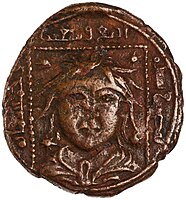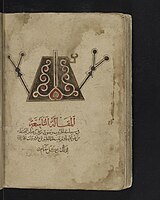Nur al-Din Arslan Shah I (or Arslan Shah) was the Zengid Emir of Mosul 1193–1211. He was successor of Izz al-Din Mas'ud. He was appointed by the Ayyubids to this position in 1193.[3] One of his slaves was Badr ad-Din Lu'lu', who became a famous ruler of Mosul, and a prominent patron of the arts.[3]
| Nur al-Din Arslan Shah I | |||||
|---|---|---|---|---|---|
| Emir of Mosul | |||||
 Turk seated facing with legs crossed, holding sword and crowned severed head, with legend to left "Nur al-Din Atabeg" (نور الدين اتا / بك), probably Nur al-Din Arslan Shah I, on a coin of Husam al-Din Yuluq Arslan, dated AH 596 (1199-1200 CE).[1][2] | |||||
| Reign | 1193-1211 | ||||
| Predecessor | Izz al-Din Mas'ud | ||||
| Successor | Izz al-Din Mas'ud II | ||||
| Died | 1211 | ||||
| |||||
| House | Zengid Dynasty | ||||
| Father | Izz al-Din Mas'ud | ||||
| Religion | Sunni Islam | ||||
In 1204, Saladin's brother and successor, the Ayyubid ruler Al-Adil I, dispatched an army under the leadership of his own son al-Ashraf of Harran, accompanied by his brother Al-Awhad Ayyub, to relieve the Zengid emir of Sinjar, Qutb al-Din, from an assault by his cousin Nur ad-Din Arslan Shah I, who was the chief Zengid emir. In April 1204 the Ayyubid coalition swiftly defeated Nur ad-Din's forces at Nusaybin, chasing them back to Mosul where they attacked several of the surrounding villages. By September the Ayyubids had established a peace with Nur ad-Din.[4]
In 1209, the Ayyubid ruler Al-Adil I again attempted to annex the Zengid states, and besieged Sinjar. Nur al-Din Arslan Shah I allied with Muzzafar al-Din Kukburi, ruler of Erbil, and resisted the Ayyubid offensive. They reached a truce, according to which al-Adid could retain the lands he conquered in Sinjar (thereafter ruled by the "Ayyubids of Mayyafariqin & Jabal Sinjar", the sons of al-Adid al-Ashraf and Al-Awhad Ayyub), and Arslan Shah would recognize Ayyubid suzerainty on his coinage.[5] As Arslan Shah's health was declining, and his sons were still young, he chose his Commander of the Army Badr al-Din Lu'lu' as protector of his sons and promoted him to atabeg upon his death in 1211.[5] The son and two grandsons of Arslan Shah continued to rule as children in Northern Iraq as Emirs of Mosul and Sinjar until 1234, when Badr al-Din Lu'lu' formally took over, possibly after assassinating the last Zengid Emir of Mosul Nasir ad-Din Mahmud.[5] He ruled in his own name from 1234 until his death in 1259, accepting Mongol suzerainty after 1243.[5][6]
The manuscript Sirr al-asrār ("Secret of secrets", LJS 459) was decicated in the name of Nur al-Din Arslan Shah I.[3] It is a text purpoted to be by Aristotle for his pupil Alexander the Great.[3] The cartouche of the frontispiece reads:
The noble king Nur al-Din atabeg Arslan Shah bin Mas'ud bin Mawdud. His victory is our Lord's. Ibn Zangi, may God prolong his reign.[3]
The Sirr al-asrār is said to have been translated from Greek to Arabic by Youhanna (Yahya) ibn al-Batriq at the court of the Abbasid caliph al-Ma'mun in the 9th century, but it may also have been directly written in Arabic. The manuscript contains ten discourses about kingship, government and the military.[3]
-
Nur al-Din Arslan Shah I, Nisbin, 594 H (Obverse)
-
Sirr al-asrār LJS 459. Frontispiece cartouche
-
Sirr al-asrār LJS 459. Drawing of a catapult-like contraption. 108v
References edit
- ^ Spengler, William F.; Sayles, Wayne G. (1992). Turkoman Figural Bronze Coins and Their Iconography: The Artuquids. Clio's Cabinet. p. 113. ISBN 978-1-879080-02-7.
But who was the "Nur al - Din Atabeg" featured on the obverse side of most coins of this type , and why was he also recognized? He is not further identified on the coins , but the most logical candidate would appear to be Nur al - Din Arslan Shah I , the Zengid Atabeg of Mosul ( 589-607 / 1193-1210 ) , the only atabeg with the laqab Nur al - Din known to have been active at that time . This identification was first advanced by Mitchiner in 1977 and was repeated by Hennequin in the Paris catalog.
- ^ Künker, Fritz Rudolf. Künker Auktion 137 - The De Wit Collection of Medieval Coins, 1000 Years of European Coinage, Part III: England, Ireland, Scotland, Spain, Portugal, Italy, Balkan, the Middle East, Crusader States, Jetons und Weights. Numismatischer Verlag Künker. p. 391.
But who was the "Nur al-Din Atabeg" featured on the obverse side of most coins of this type, and why was he also recognized? He is Nur al-Din Arslan Shah I, the Zengid Atabeg of Mosul (1193-1210), which was discovered by Mitchiner in 1977. Why the Artuqid Yuluq Arslan of Mardin should put his rival's name on his coins is not altogether clear
- ^ a b c d e f Canby et al. 2016, p. 60.
- ^ Humphreys, 1977, p. 128.
- ^ a b c d Patton, Douglas (1991). "Badr al-Dīn Lu'lu' and the Establishment of a mamluk Government in Mosul". Studia Islamica (74): 81. doi:10.2307/1595898. ISSN 0585-5292.
- ^ Pubblici, Lorenzo (2021). Mongol Caucasia. Invasions, conquest, and government of a frontier region in thirteenth-century Eurasia (1204-1295). Brill. p. 145. ISBN 978-90-04-50355-7.
1243 (...) With much astuteness, Hethum I, who did not wait for the Mongols' arrival, immediately declared himself to be the subject and vassal of the noyons of Ögedei. He entered under Mongol protection and managed to exercise his sovereignty precisely as he had done until then and paid tribute to the Mongols. A similar strategy was followed by the atabeg of Mosul, who willingly accepted Mongol protection and spared the lives of its people.
Sources edit
Canby, Sheila R.; Beyazit, Deniz; Rugiadi, Martina; Peacock, A. C. S. (27 April 2016). Court and Cosmos: The Great Age of the Seljuqs. Metropolitan Museum of Art. p. 60, item 10. ISBN 978-1-58839-589-4.


